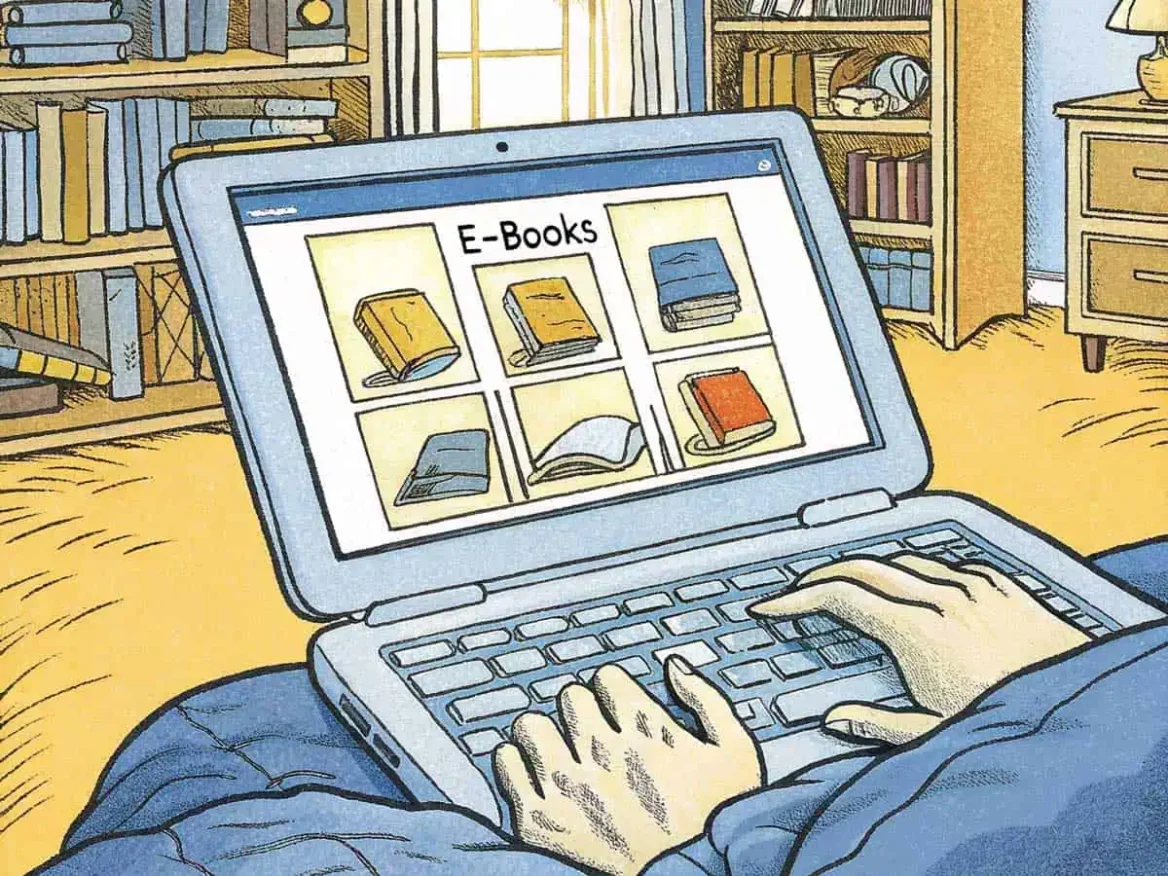In this article, I analyse whether Tom Cabinet’s sale of second-hand e-books constitutes a “communication to the public” under copyright law.
‘If you liked the Millennium trilogy, I also know another book series you can enjoy. And it will keep you busy for a while; it’s three such thick books.’ He holds his thumb and index finger slightly apart, from which I can tell that these are indeed several kilos of reading pleasure that might make commuting by train more pleasant.
Later that week, I find in my e-mail box a link to www.tomkabinet.nl with an explanation from my literature consultant: ‘They sell that book series here too, just sign up and you’ll have those books on your e-reader in no time (because environmental)’. And indeed, there is virtually no more than signing up, as I read on the website about Tom’s Reading Club: ‘No, there is no membership or subscription and you are not tied to anything. You always pay the low €2 purchase fee per ebook + the credits that an ebook costs. You get credits for every valid ebook you sell or by ordering them along with your purchases.’
Authors have apparently been thought of too: ‘Authors receive a standard €0.50 royalty for every ebook sold through Tom Cabinet. Want to know if this compensation to authors is fair? Then check the page Fair to authors for a calculation.’
Publishers are not eager
Sounds like a mighty idea, were it not for the fact that publishers are less eager for this concept. Since 2014, the Dutch Publishers Association and Group of General Publishers on the one hand and Tom Kabinet on the other have been litigating whether this new form of exploitation of works violates authors’ rights.
For the judges of the Amsterdam and The Hague courts, it was certainly not a done deal (See Amsterdam District Court 21 July 2014, ECLI:NL:RBAMS:2014:4360, Amsterdam Court of Appeal 20 January 2015, ECLI:NL:GHAMS:2015:66, The Hague District Court 12 July 2017, ECLI:NL:RBDHA:2017:7543). Accordingly, preliminary questions were almost immediately referred to the Court of Justice, which were answered on 19 December 2019 (C-263/18, ECLI:EU:C:2019:1111).
New forms of exploitation
The Court’s judgment fits into the line of rulings dealing with new forms of exploitation and the adaptation of IP rights to new economic developments, such as the UsedSoft judgment on the exhaustion of computer programs (CJEU 3 July 2012, C-128/11, ECLI:EU:C:2012:407 (UsedSoft)) and the VOB v Stichting Leenrecht judgment on the lending of e-books (CJEU 10 November 2016, C-174/15, ECLI:EU:C:2016:856 (VOB v Stichting Leenrecht)).
Both judgments are also briefly cited by the Court in the case between the publishers and Tom Kabinet.
Tom Cabinet deals in e-books under the name Toms Leesclub. Briefly, members of Toms Reading Club can purchase an e-book for €2 each. The e-books are purchased by Tom Cabinet or donated by Tom Cabinet members.
Do not keep a copy
In the latter case, members provide the download link of the e-book and declare that they do not keep a copy of the e-book. Tom Cabinet downloads the book, puts a watermark on it to show that it is a legally purchased book and then offers it to its members. According to the publishers, Tom Cabinet’s conduct, among other things, involves unauthorised communication to the public of e-books.
Prohibited work to be copied
Before we go into the rest of this case, a brief bit of theory: Based on copyright, a creator has the exclusive right to disclose and/or reproduce his work. In short, this means that a creator can prohibit someone else from copying (reproducing) a work and/or posting (disclosing) a work on a website.
As far as duplication is concerned, we can be brief in this article: although it has been discussed in the lower courts that Tom Cabinet may have unlawfully duplicated the e-books with its conduct, no preliminary questions have been raised or answered on this issue.
While this is an equally interesting issue, it will not be discussed further – partly due to limiting the scope of this article.
The concept of disclosure included in the Dutch Copyright Act refers to the concepts of “communication to the public” and “distribution to the public” from Directive 2001/29/EC (“the Copyright Directive”).
The so-called communication to the public
Communication to the public occurs when persons, who are not at the place of origin of the communication, are given the opportunity to see or hear a work. Two cumulative elements are relevant in this case, namely ‘an act consisting of communication’ of a work and its communication to a ‘public’ (CJEU 31 May 2016, C-117/15, EU:C:2016:379, Reha Training v GEMA, paragraphs 35-37).
As regards the ‘act consisting in communication’, what matters is that the public is or has been given the opportunity to access a work at an individually chosen place and time (CJEU 26 March 2015, C-279/13, EU:C:2015:199, C More Entertainment, paragraphs 24-25). Whether this possibility is actually used is not decisive (CJEU 14 June 2017, C-610/15, EU:C:2017:456, Brein Foundation, para 31).
A fairly large number of people
The term ‘public’ refers to an indeterminate number of potential viewers and implies a fairly large number of individuals. In connection with the ‘indeterminacy of the public’, a work should be made perceptible to persons in general, i.e. not only to specific individuals belonging to a private group. A fairly large number of persons further presupposes a certain ‘deminimis threshold’, which means that a (too) small number of persons involved do not fall under this concept.
However, the number of persons who have access to the same work at the same time must be taken into account, as well as the number who may have access to it consecutively (CJEU 31 May 2016, C-117/15, EU:C:2016:379, Reha Training v GEMA, para 41-44).
In addition, either a different specific technical method used up to then must be used to make the communication to the public or the communication must be aimed at a different audience than the copyright holders had considered (a new audience).
Distribution to the public
As for distribution to the public, this refers to “any form of distribution to the public of the original of their works or copies thereof, by sale or otherwise”.
The court has held, inter alia, that this is a series of acts that, in any case, extends from the conclusion of a contract of sale to its performance by delivery to a member of the public (CJEU 13 May 2015, C-516/13, ECLI:EU:C:2015:315, Dimensione/Knoll, para 25).
Back to the case of Tom Cabinet
With the above in mind, we return to the case of Tom Cabinet, the discussion between the parties that prompted the District Court of The Hague to refer preliminary questions to the Court.
The Court rephrased the court’s question to whether providing an e-book for unlimited use via a download link falls within the concept of “communication to the public” or “distribution to the public” within the meaning of the Copyright Directive.
The Court then comes to the comprehensive and clear conclusion that, in short, any communication to the public of a work, excluding the distribution of material copies of it, falls within communication to the public.
Physical copies that can be put into circulation in the form of tangible objects are covered by the provision dealing with the creator’s distribution right.
Tom Cabinet and the UsedSoft ruling
But how then do these conclusions translate with the UsedSoft judgment, which correctly ruled that computer licences (not physical copies) do fall under the distribution right?
The Court explains as follows: the UsedSoft judgment concerned the interpretation of the concept of distribution within the meaning of Directive 2009/24/EC of the European Parliament and of the Council of 23 April 2009 on the legal protection of computer programs.
This directive deals with the protection of tangible and intangible copies of computer programs and is lex specialis to the Copyright Directive. Moreover; an e-book is not a computer program, the Court explicitly considers. A reliance on UsedSoft therefore does not apply to Tom Cabinet for that reason.
The conduct of Tom Cabinet
Thus, what matters next for the issue between the parties is whether Tom Cabinet’s conduct constitutes a communication to the public.
According to the Hague court, this is not the case; the content of an e-book is not made public when it is offered for sale on Tom Kabinet’s platform.
In addition, there is no public, as an e-book is made available (only) to one member of the reading club, the court ruled. As mentioned, two cumulative conditions, namely ‘an act consisting of a communication’ of a work and its communication to a ‘public’, are important in determining whether there is a communication to the public.
With regard to the first cumulative condition (communication), the Court considered that, with regard to all the works available by Tom Kabinet, persons registered as members of Toms Reading Club can decide for themselves where and when to consult the books, which, according to the Court, does constitute communication of a work, without the members having to make use of the possibility of actually retrieving the e-books from the website.
Via Tom Cabinet’s platform
With regard to the second condition, the Court considers that a significant number of persons may simultaneously or consecutively access the same work through Tom Cabinet’s platform.
In this regard, the Court refers (by analogy) to the VOB judgment (cited above). In that judgment, it was held that in the event that an e-book is placed on the server of a public library and it is made possible for a user to reproduce a copy of the ebook by downloading it onto his own computer, in such a way that during the lending period only one copy can be downloaded and after the lending period the copy can no longer be used by the user, it exhibits characteristics similar to the lending of a physical book.
After all, in either case (digital or physical lending), the library’s lending capacity does not increase and lending is temporary.
Technical measure
No such technical measure was applied by Tom Kabinet. The Court therefore considers that, subject to review by the District Court of The Hague taking into account all relevant data, the e-books are ‘communicated to the public’ by Tom Kabinet within the meaning of the Copyright Directive.
Finally, the court considered that an e-book is generally accompanied by a licence that allows the user of an e-book to read an e-book only on his own equipment. However, Tom Cabinet’s conduct makes this an audience that the copyright holders had not already considered, and thus a new audience.
In view of the above, the Court finds that the conditions for making a communication to the public by supplying the public with an e-book to be used indefinitely via a download link are met.
Comment
The way Tom Kabinet has currently designed its trading platform in ‘second-hand’ e-books will – as it now appears – possibly be banned by the courts, as this involves communication to the public, or publication, without the consent of the rights holders.
Given the Court’s reference to the VOB judgment, which held that in the event that the digital lending process is more or less the same as the physical lending process, this falls under the concept of ‘lending’ and the corresponding rights and obligations, it is understandable that the concept of Tom Cabinet as it is currently set up cannot be maintained.
After all, a (second-hand) e-book can now be read by several (and perhaps a large number of) people at once, while a second-hand book is generally only read by one person. Should Tom Cabinet be able to change this, it might be able to set up a legitimate buying and selling system of (second-hand) e-books. The question then remains whether Tom Cabinet is not unlawfully reproducing. So, as indicated, no clear answer has been given to this question so far. Perhaps this point will still be raised at the court in The Hague in subsequent proceedings.
Not entirely unexpected
Tom Kabinet’s attempt to respond to developments in new forms of exploitation is not entirely unexpected, given also the new ways in which music and film are currently (also) being exploited (think Spotify and Netflix). Tom Cabinet itself has also indicated to publishers that it is its intention to take all interested parties into account. On the day Tom Cabinet offered (one of the first versions of) its service, it wrote to several publishers, saying, among other things:
‘You may fear a decline in sales of (new) e-books. However, the fact is that currently 1 in 11 e-books read are from illegal sources. There is an urgent need to take action on this. The Netherlands is lagging behind when it comes to e-book sales. Research consistently shows that the Dutch would buy more e-books if they were cheaper. Tom Cabinet aims to make a fair system for all parties. Selling second-hand e-books can create a chain reaction.’
At the time, Tom Cabinet’s business model was set up so that €0.05 per e-book sold would go to the rights holder. So currently, this is €0.50 (see introduction). Tom Cabinet subsequently added:
‘Tom hopes, nay expects, that we can become friends. The intentions are good. Tom is open to your suggestions, and wants to work with you to arrive at a good and fair system that delights authors, publishers and readers alike.’
Tom Kabinet’s approach (do first, then talk) did not go down well with the publishers, given the proceedings between the parties. Not entirely incomprehensible when considering the argument put forward by the publishers during the summary proceedings before the Amsterdam District Court (dated 21 July 2014, ECLI:NL:RBAMS:2014:4360):
“the fragile balance in the e-book market, a market suffering from widespread piracy”.
Nevertheless, it could nevertheless be a great opportunity (also) for publishers to explore whether it is copyright – and economically – feasible to arrive at a sales model for second-hand e-books that is indeed, as Tom Kabinet claims to hope, fair and one that delights authors, publishers and readers alike. Before it gets to that point (or before anyone at all makes the next attempt to arrive at a system that does comply with authors’ rights), we will probably have to wait for the ruling of the court in The Hague.
This article was published on 31 January 2020 in JutD 2020-0005. The version on this website contains some minor edits and new headings.


